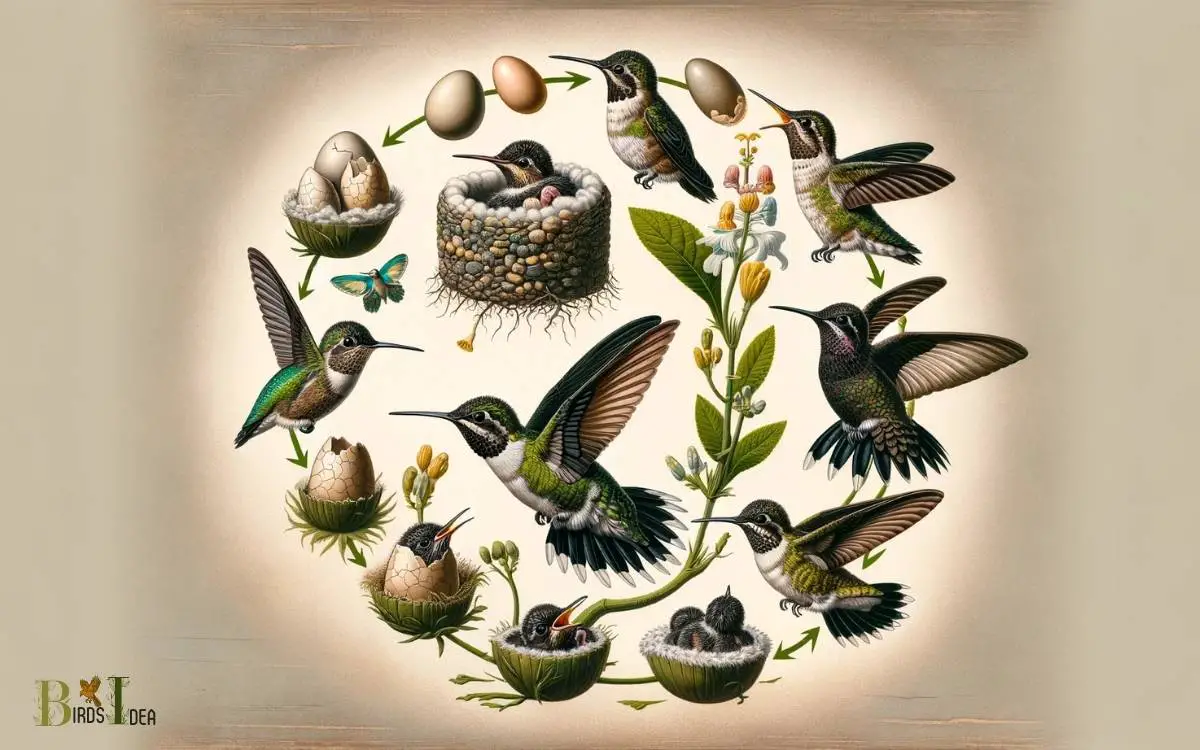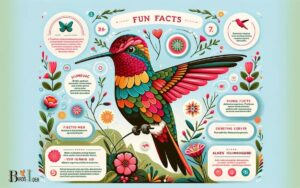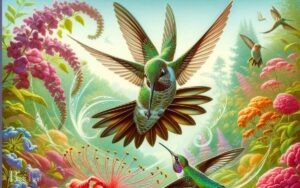Black-chinned Hummingbird Life Cycle: Explain!
The life cycle of the Black-chinned Hummingbird is a sequence of well-defined stages including nest building, egg laying, incubation, hatching, chick rearing, fledging, and post-fledging, each showcasing the bird’s adaptability and tenacity for survival.
This cycle illustrates the Black-chinned Hummingbird’s journey from constructing a delicate nest to successfully raising its offspring.
The Black-chinned Hummingbird’s life cycle starts with the female selecting a site and building a nest using spider webs and plant materials. She then lays typically two eggs, which she incubates for about two weeks.
After hatching, the chicks are fed by the mother for approximately three to four weeks until they fledge.
Post-fledging, the juveniles learn to feed on nectar and insects while still occasionally being fed by the mother.
Discover the enthralling stages of the Black-chinned Hummingbird, from nest building to the young taking flight.

Key Takeaway
7 Stages of Black-chinned Hummingbird Life Cycle
| Stage | Duration | Activities and Characteristics |
|---|---|---|
| Nest Construction | Variable | Use of spider silk and plant materials; nest size of ~2 inches in diameter |
| Egg Laying | 1-2 days | Typically two white eggs are laid |
| Incubation | Approximately 14 days | Female incubates, leaving briefly to feed |
| Hatching | 2-3 days | Chicks emerge featherless and with closed eyes |
| Chick Development | 3-4 weeks | Mother feeds chicks with regurgitated nectar and insects |
| Fledging | 3-4 weeks | Young birds leave the nest, still fed by the mother occasionally |
| Post-Fledging | Several weeks | Juveniles learn to forage independently, still within the mother’s territory |
Nest Construction
During the breeding season, female black-chinned hummingbirds construct their nests using fine plant material, spider silk, and other soft fibers, creating a small, cup-shaped structure.
These nests are often situated in the forked branches of trees or shrubs, where they are well-camouflaged and protected from the elements.
The meticulous construction process involves intricate weaving and binding of materials to form a secure and insulating nest for the upcoming eggs.
The female hummingbird invests significant time and effort in this process, ensuring that the nest provides a safe environment for her offspring.
The result is a remarkable feat of avian engineering, perfectly suited to the needs of the tiny inhabitants.
This delicate and intricate process showcases the remarkable adaptability and resourcefulness of the black-chinned hummingbird during the crucial breeding period.
Egg Incubation
As we transition to the next stage of the Black-chinned Hummingbird life cycle, it is important to understand the significance of egg incubation.
This process is essential for maintaining the warmth required for the development of the embryos.
Additionally, both parent birds share the duties of incubation, with the length of this period varying based on environmental factors.
Egg Warmth Essential
The egg warmth is essential for the successful incubation of Black-chinned Hummingbird eggs.
The female Black-chinned Hummingbird usually lays two white, pea-sized eggs in a nest made of plant fibers and down, about the size of a quarter.
Once the eggs are laid, the female is solely responsible for keeping them warm. She accomplishes this by sitting on the eggs, using the heat from her body to regulate the temperature.
The duration of egg incubation is typically around 16-18 days. During this time, the mother hummingbird diligently maintains the warmth needed for the eggs to develop.
Maintaining the proper warmth is crucial, as any significant temperature fluctuations could negatively impact the development of the embryos.
Therefore, consistent and appropriate egg warmth is vital for the successful hatching of Black-chinned Hummingbird eggs.
Parental Sharing Duties
Parental collaboration during egg incubation is a critical aspect of the Black-chinned Hummingbird life cycle. After the female lays her eggs, both the male and female share the responsibility of keeping the eggs warm.
The female typically spends more time incubating the eggs during the day, while the male takes over at night.
This division of labor allows the eggs to receive constant warmth, essential for successful development.
The delicate balance of sharing these duties ensures that the eggs are consistently kept at the optimal temperature, maximizing the chances of successful hatching.
This collaborative effort highlights the dedication of both parents in ensuring the survival of their offspring, a crucial stage in the Black-chinned Hummingbird life cycle.
Incubation Period Varies
During egg incubation, the length of the incubation period varies among Black-chinned Hummingbirds, impacting the timing of hatching and chick development.
The incubation period for Black-chinned Hummingbird eggs typically ranges from 14 to 16 days.
Factors such as temperature, humidity, and the individual bird’s nesting behavior can influence the duration of this period.
For instance, during cooler weather, the incubation period may be longer, while in warmer conditions, it may be shorter.
Additionally, variations in the attentiveness of the parent birds during incubation can also affect the time it takes for the eggs to hatch.
This variability in the incubation period plays a crucial role in determining the developmental stage of the chicks at hatching, influencing their vulnerability and the timing of subsequent developmental milestones.
Hatching Process
The hatching process is a critical stage in the life cycle of the Black-chinned Hummingbird. This period marks the end of the egg incubation period and the beginning of nestling development stages.
Maternal care behavior plays a crucial role during this time, ensuring the survival and well-being of the hatchlings.
Egg Incubation Period
The egg incubation period of the black-chinned hummingbird lasts approximately 14 to 16 days. During this time, the female black-chinned hummingbird diligently sits on her nest, keeping the eggs warm and protected.
The mother will frequently leave the nest to feed and regain her energy, but she ensures the eggs are well-insulated during her absence.
The eggs are kept at an optimal temperature of around 96 degrees Fahrenheit due to the warmth generated from the mother’s body.
As the incubation period progresses, the embryos develop within the eggs, and soon the hatchlings will be ready to emerge.
| Development Stage | Time Frame |
|---|---|
| Egg Laying | 1-2 days |
| Incubation | 14-16 days |
| Hatching | 1-2 days |
Maternal Care Behavior
With a compound noun in mind, let’s begin the subtopic of ‘Maternal Care Behavior (Hatching Process)’ by stating:
- Nest Maintenance: The female hummingbird diligently maintains the nest, ensuring it provides a secure and comfortable environment for the eggs.
- Regulation of Incubation: She regulates the temperature of the eggs by sitting on them for the majority of the day, using her body heat to facilitate the incubation process.
- Egg Rotation: Periodically, the female will delicately rotate the eggs to ensure they receive uniform heat distribution, promoting healthy embryonic development.
- Protection from Predators: Throughout the incubation period, the female fiercely defends the nest, warding off potential threats to safeguard the eggs and ensure a successful hatching process.
Female black-chinned hummingbirds exemplify remarkable dedication and care during the hatching process, ensuring the survival of their offspring.
Nestling Development Stages
During the nestling development stages, black-chinned hummingbirds undergo a rapid growth process, marked by distinct developmental milestones.
The hatching process of black-chinned hummingbirds can be divided into several stages, each with its own unique characteristics.
Below is a table outlining the key stages of nestling development:
| Nestling Development Stage | Description | Duration |
|---|---|---|
| Egg Stage | From egg laying to hatching | 15-18 days |
| Hatchling Stage | Helpless, naked, and eyes closed | 18-22 days |
| Nestling Stage | Feathers start to develop | 20-25 days |
As the nestlings progress through these stages, their physical and behavioral traits undergo significant changes, preparing them for the next phase of their life cycle.
Chick Development
At the beginning of the chick development stage, the black-chinned hummingbird’s eggs will start to hatch.
This marks the start of an incredible transformation as the chicks begin their journey toward fledging.
During this stage:
- Feeding: The adult hummingbirds diligently feed the chicks a diet of regurgitated nectar, small insects, and spiders to ensure they receive the necessary nutrients for growth.
- Growth: The chicks grow rapidly, doubling in size within the first few days. Their tiny bodies develop feathers, and they become more active and vocal.
- Fledging: After about 18-22 days, the chicks are ready to leave the nest, although they may still rely on their parents for food and protection for a few more weeks.
- Independence: Eventually, the young hummingbirds will become independent and begin their own journey in the world.
Feeding Behavior
The black-chinned hummingbird demonstrates remarkable feeding behavior, ensuring the chicks receive essential nutrients for growth through a diet of regurgitated nectar, small insects, and spiders.
Adult hummingbirds use their long, specialized bills to reach deep into flowers to obtain nectar, which is a vital energy source for both adult birds and their chicks.
They also catch insects and spiders in mid-air or by gleaning them from leaves, contributing necessary proteins and fats to their diet.
This diverse feeding strategy allows the black-chinned hummingbird to provide a well-rounded, nutritious diet for their chicks, supporting their rapid growth and development.
By incorporating a variety of food sources, these hummingbirds adeptly navigate their ecosystem, ensuring the survival and thriving of their young.
Fledging Stage
Upon reaching the fledging stage, black-chinned hummingbird chicks undergo a critical period of learning essential survival skills before becoming independent.
This stage is crucial for their development and involves several significant behaviors:
- First Flights: Chicks begin to exercise their wings and take short flights, gradually building strength and agility.
- Foraging Skills: They learn to identify and consume natural nectar sources and small insects, essential for their nutrition.
- Territorial Awareness: Chicks start to understand their territory and the locations of reliable food sources, which is vital for their survival.
- Predator Avoidance: They acquire techniques to evade potential predators, such as hawks and snakes, to enhance their chances of survival.
The fledging stage is a pivotal time when these young hummingbirds acquire the skills necessary for their future independence and survival in the wild.
Post-Fledging Period
Entering the post-fledging period, black-chinned hummingbirds continue to refine their foraging skills and territorial awareness, further solidifying their ability to thrive independently in the wild.
During this critical phase, young hummingbirds rely on nectar as their primary food source, but they also begin to explore and incorporate small insects and spiders into their diet, broadening their nutritional intake.
They become increasingly adept at hovering and maneuvering in mid-air, honing their agility to capture elusive prey.
Additionally, they learn to identify and defend suitable feeding territories, establishing their own space within the larger hummingbird community.
This period is essential for their survival as it marks the transition from being dependent fledglings to self-sufficient, competent individuals capable of navigating the complexities of their environment.
Conclusion
The black-chinned hummingbird life cycle is a fascinating and intricate process. From nest construction to the post-fledging period, each stage is crucial for the survival and growth of the chicks.
The resilience and determination of the hummingbird parents in providing for their young is akin to a well-oiled machine, ensuring the continuation of the species.
This cycle of life serves as a reminder of the natural order and the importance of nurturing and protection.






